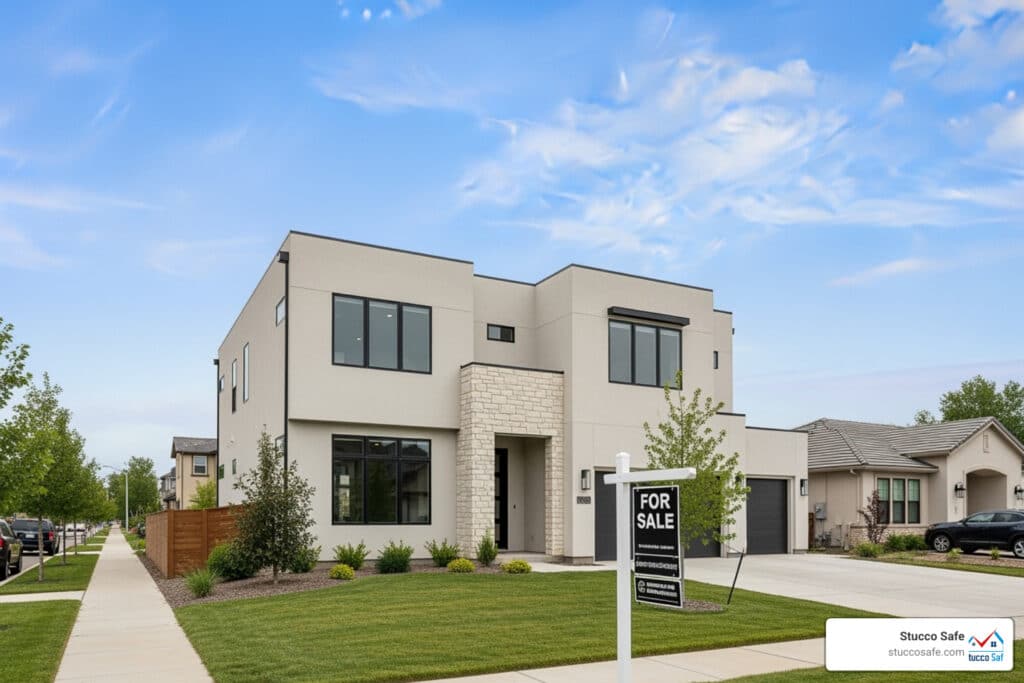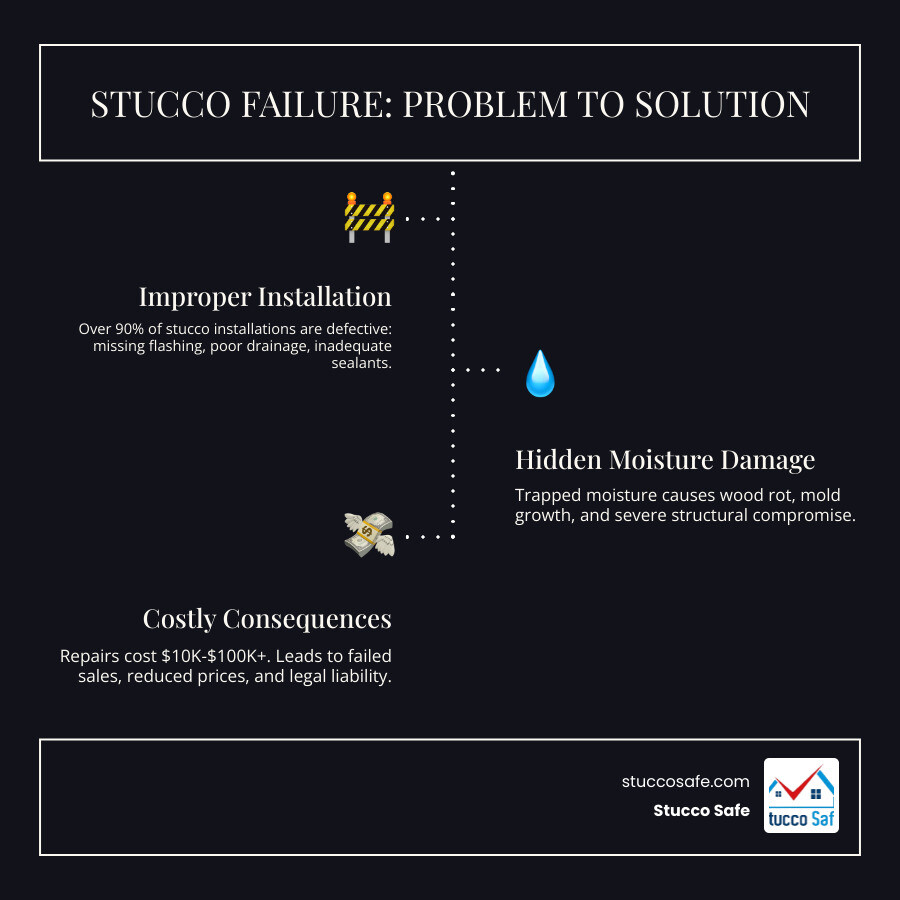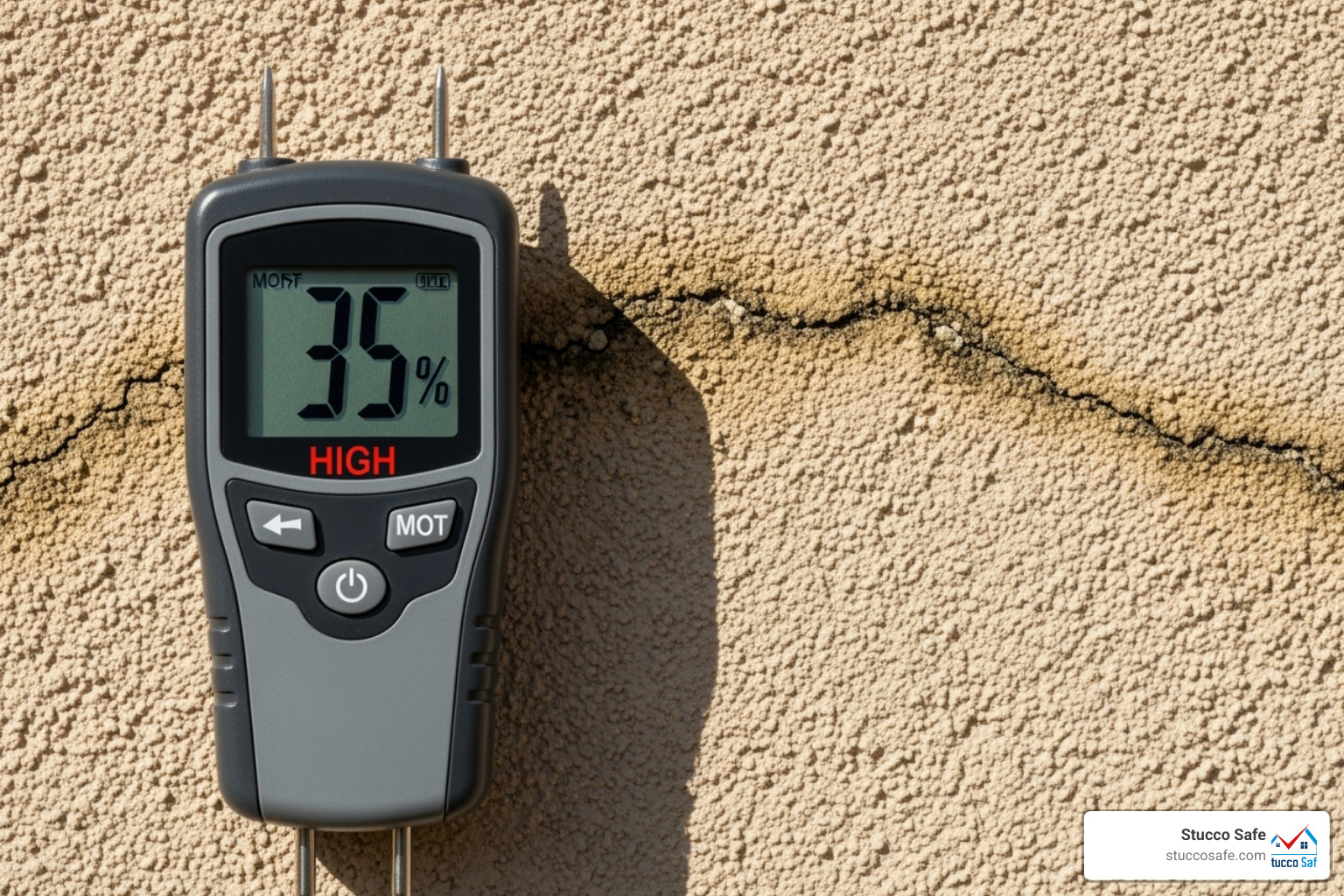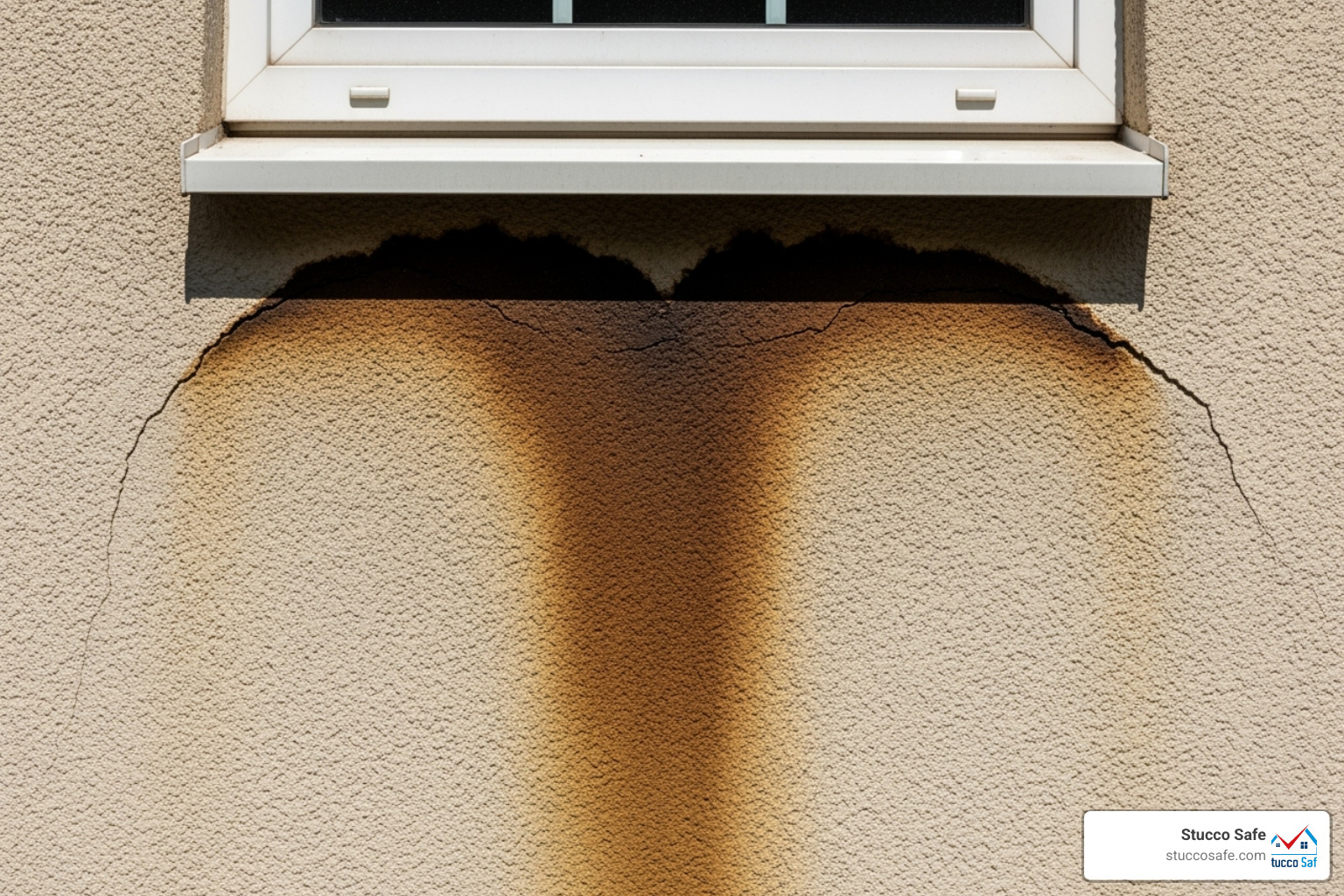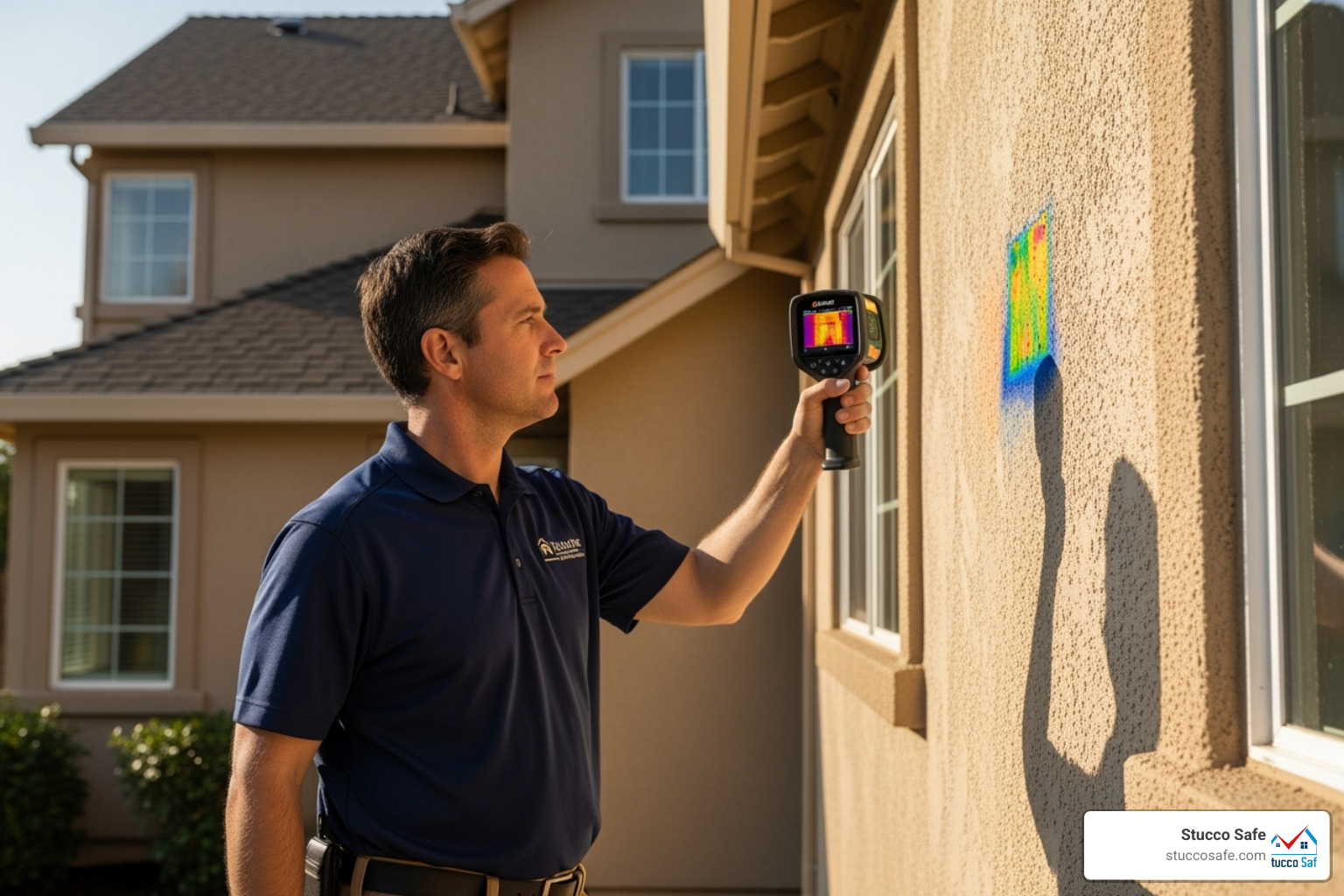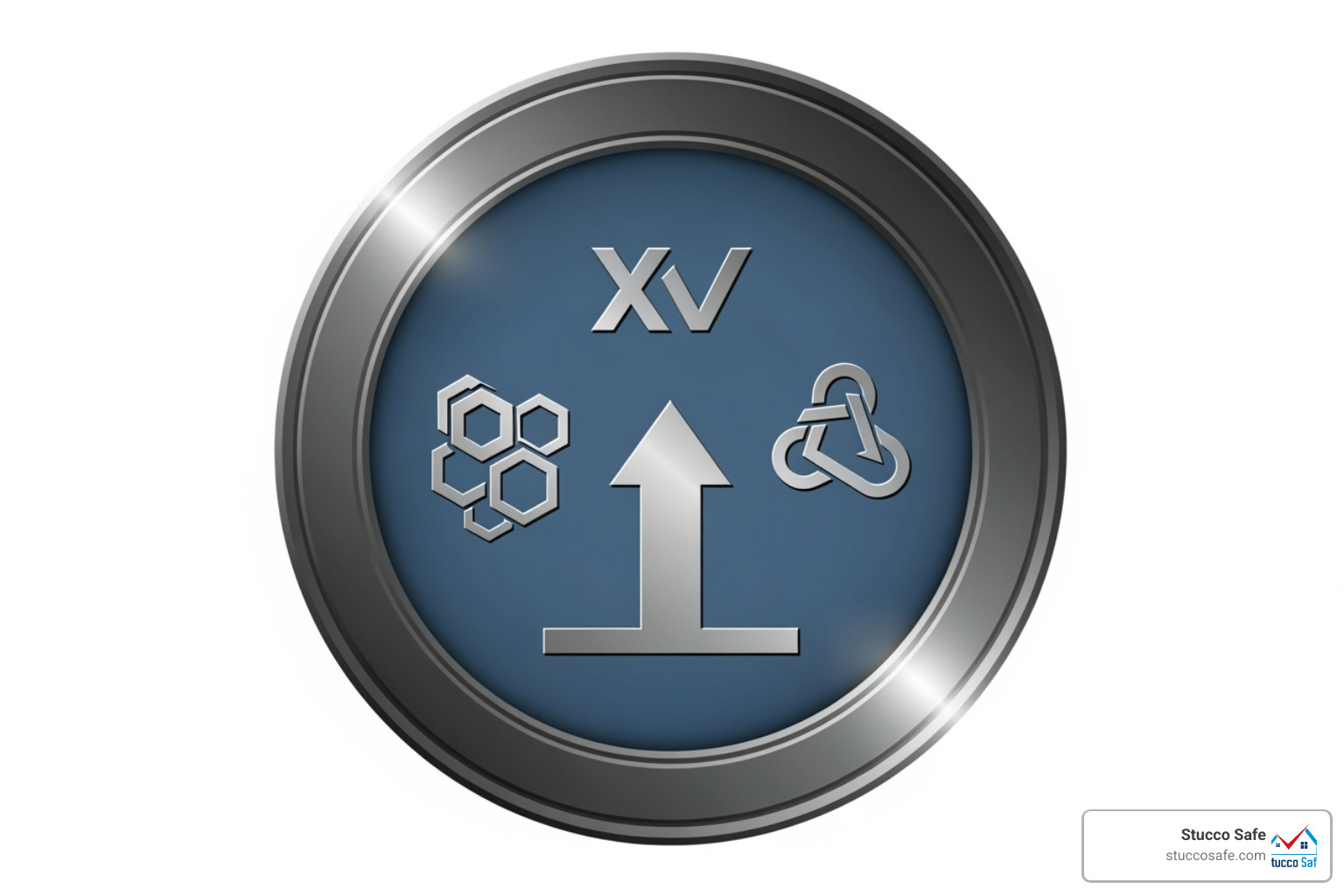Stucco Inspection for Home Sale: Avoid 2025 Pitfalls
The Hidden Risks of Stucco in Real Estate Transactions
A stucco inspection for home sale is a specialized examination that detects hidden moisture damage and structural issues behind stucco exteriors, protecting both buyers and sellers from costly surprises. Here’s what you need to know:
For Sellers:
- Get a pre-listing inspection to identify issues early.
- Control repair costs by addressing problems on your terms.
- Attract confident buyers with a clean inspection report.
- Avoid last-minute deal complications.
For Buyers:
- Include a stucco inspection contingency in your offer.
- Budget $495 to $1,595+ for the inspection.
- Use findings to negotiate repairs or price reductions.
- Protect yourself from hidden damage that can cost tens of thousands to fix.
Stucco homes offer great curb appeal, but beneath that attractive exterior, serious problems can lurk. An estimated 90% of stucco applications from the last 15 to 30 years are defective. When moisture gets trapped behind stucco, it can cause wood rot, mold growth, and structural damage that costs tens of thousands of dollars to remediate.
The core issue is that many stucco systems were installed incorrectly, especially in homes built between 1993 and 2006. Critical details like proper flashing and drainage planes are often missing, creating a perfect environment for moisture intrusion. For buyers, this means a beautiful property could be a financial nightmare. For sellers, undisclosed issues can derail a sale or lead to legal liability.
A professional stucco inspection uncovers these hidden problems before they become deal-breakers. This guide walks you through what a specialized stucco inspection uncovers, how it differs from a standard home inspection, and how to steer repairs and negotiations with confidence.
I’m Gabe Kesslick, an EDI Level 2 Certified Stucco Inspector with over 20 years of experience. I founded Stucco Safe in 2015 to help homeowners, buyers, and sellers address stucco issues through comprehensive stucco inspection for home sale services. My team and I have conducted thousands of inspections across Southeastern Pennsylvania, New Jersey, and Delaware, providing the clarity needed to protect your investment.
Why a Stucco Inspection is Essential in a Home Sale
A stucco inspection for home sale is your best defense against hidden problems that could turn a dream home into a financial nightmare. Stucco can look perfectly fine on the outside while serious damage is happening behind the scenes. Because stucco is porous, moisture can get through. If the system underneath lacks proper flashing or a drainage plane, that moisture gets trapped and starts destroying the wood framing, insulation, and structural integrity of the home.
The damage happens silently, often going undetected for years. Wood rot eats away at the home’s framing, mold growth creates health hazards, and the structural integrity of the building can be compromised. Studies show that nearly 50% of stucco systems in Philadelphia have some form of leakage. Because these moisture problems with stucco compound over time, a small leak can eventually require a full remediation costing $50,000 or more.
A general home inspector isn’t equipped to find these issues. You need a specialist who knows exactly what to look for.
What a Stucco Inspection Uncovers
A professional stucco inspection for home sale is like having X-ray vision for your walls. We focus on every vulnerable area where water can get in, including:
- Moisture intrusion points: Gaps around windows, doors, and where the roof meets the walls.
- Improper flashing: Missing or incorrectly installed flashing that fails to direct water away from the home.
- Missing weep screeds: The absence of components at the bottom of walls that allow trapped moisture to drain out.
- Substrate condition: We check the wood sheathing behind the stucco for softness, rot, or water stains.
- Sealant failure: Cracked or shrinking sealant around windows and doors creates a direct path for water.
- Cracks and delamination: Large cracks or areas where stucco is pulling away from the wall can indicate underlying moisture damage.
We also look for subtle stucco house issues like water stains, bubbling paint, or soft spots.
How it Differs From a General Home Inspection
A general home inspector is a generalist; a specialized stucco inspector is an expert in one complex system. The difference is critical.
-
Scope and Time: A general inspector spends minutes on the stucco as part of a whole-house review. We spend hours focusing exclusively on the stucco system.
-
Specialized Tools: We use tools a generalist doesn’t carry, like thermal imaging cameras to see temperature differences indicating moisture and electronic moisture meters to measure water content within the walls.
-
Inspector Qualifications: Our inspectors hold specialized certifications from organizations like the Exterior Design Institute (EDI). This training in forensic testing methods allows us to spot subtle warning signs that others miss.
A visual-only inspection—which is all a general inspector can typically provide for stucco—cannot detect moisture trapped inside walls. A specialized stucco inspection for home sale goes far beyond a surface check, as detailed in our guide on what a stucco inspection is. It’s a dedicated, forensic examination that reveals what’s really going on behind your walls.
For Sellers: Proactive Steps to a Smooth Stucco Home Sale
If you’re selling a stucco home, the best strategy is to get ahead of potential problems. A pre-listing stucco inspection for home sale isn’t admitting defeat—it’s taking control of the transaction. It allows you to find and fix issues on your own schedule, rather than being surprised during a buyer’s inspection when you’re under pressure.
Getting an inspection before you list lets you attract confident buyers, avoid last-minute surprises, control repair costs, and ensure a faster closing timeline. When you can provide a clean inspection report or proof of completed repairs, you stand out from other listings and give buyers the confidence to make an offer.
Common Signs of Stucco Damage to Watch For
Before calling a professional, walk around your home and look for these warning signs:
- Cracks: Large, spiderweb, or stair-step cracks can signal serious moisture issues.
- Water stains: Dark streaks under windows or along rooflines are clear evidence of water intrusion.
- Bubbling or blistering: This happens when moisture gets trapped and lifts the stucco off the wall.
- Mold or mildew: Green, black, or white patches indicate a persistent moisture problem.
- Loose or crumbly sections: Stucco that feels soft or hollow when tapped suggests the material underneath is compromised.
- Gaps around windows and doors: Even small separations create entry points for water.
If you spot any of these signs, it’s time for a professional Home Sellers Stucco Inspection.
The Strategic Advantage of a Pre-Listing Inspection
A pre-listing stucco inspection for home sale gives you leverage, knowledge, and peace of mind.
- Set a Fair Price: Price your home accurately based on its true condition.
- Ensure Full Disclosure: A pre-listing inspection demonstrates good faith and reduces your future liability. This is a key topic in The Realtor’s Guide to Stucco.
- Gain a Marketing Advantage: Advertising a completed professional inspection makes your listing more attractive to serious buyers.
- Streamline Negotiations: Knowing the facts prevents you from being caught off guard and allows you to negotiate from a position of strength.
- Repair on Your Own Terms: You can get competitive bids and oversee repairs without the pressure of a closing deadline, saving you thousands compared to a buyer’s repair credit demand.
A pre-listing inspection is an investment that pays for itself through a smoother, more profitable sale.
For Buyers: Protecting Your Investment in a Stucco Home Purchase
When buying a stucco home, due diligence is critical. Hidden damage behind seemingly perfect walls can lead to repairs costing tens or even hundreds of thousands of dollars. A stucco inspection for home sale is your tool to understand exactly what you’re buying and ensure your investment is sound.
The inspection typically costs between $495 and $1,595—a small price for the peace of mind it provides. Our Home Buyers Stucco Inspection service is designed to give you that protection.
Key Steps in the stucco inspection for home sale
Follow these steps to safeguard your investment:
- Include an Inspection Contingency: Make your purchase offer conditional on a satisfactory stucco inspection. This gives you the legal right to negotiate or walk away if serious problems are found.
- Hire a Qualified Inspector: Do not rely on your general home inspector. You need a specialist with certifications from organizations like the Exterior Design Institute (EDI).
- Negotiate Payment: The buyer usually pays for the inspection, but this can be negotiated. The current homeowner must grant permission for the inspection.
- Schedule Early: Book the inspection early in your contingency period to allow time for review, estimates, and negotiations.
- Attend the Inspection: Being present allows you to ask questions and gain a understanding of the home’s condition.
Understanding the Inspection Report and Negotiation Tactics
Your detailed inspection report is your most valuable negotiation tool. Review it carefully with your inspector and real estate agent, paying close attention to high moisture readings, which indicate serious problems.
The report will include recommended repairs, giving you several paths forward:
- Ask for Repair Credits: Request a credit at closing to cover the estimated cost of repairs. This gives you control over the work.
- Request Seller Repairs: Ask the seller to complete the repairs before closing. Insist on qualified contractors and verify the work with a follow-up inspection.
- Negotiate a Price Reduction: If damage is extensive, a price reduction can compensate you for the cost, time, and risk of taking on the repairs yourself.
- Walk Away: If the damage is too severe or you can’t reach a fair agreement, your contingency allows you to terminate the contract and get your earnest money back.
The inspection report provides the leverage you need to negotiate fairly and protect your finances.
Decoding the Stucco Inspection Process: From Visual Checks to In-Depth Testing
When you schedule a stucco inspection for home sale, our certified inspectors conduct a forensic investigation to build a complete picture of your stucco system’s health. We follow rigorous standards, combining visual expertise with technology to answer one critical question: Is moisture getting behind the stucco, and what damage has it caused?
Our Stucco Inspection and Testing process is multi-layered, and many of our inspectors hold certifications from organizations like InterNACHI, ensuring a high standard of professionalism.
Types of Stucco Inspections
The depth of our investigation depends on the home’s age, risk factors, and initial findings.
-
Visual Inspection: We start by walking the entire property, looking for red flags like cracks, stains, bubbling, and gaps. However, a visual check has limits, as serious damage can hide behind a perfect-looking surface.
-
Non-Invasive Methods: We use technology to see what’s invisible to the naked eye. Thermal imaging cameras detect temperature variations that indicate hidden moisture. Electronic moisture meters provide precise readings from the surface without causing damage.
-
In-Depth Intrusive Testing: When non-invasive testing suggests moisture or the home is high-risk, we recommend intrusive testing. This is the gold standard for confirming hidden damage. We strategically drill small, discreet holes (less than a quarter-inch) and insert probes to measure moisture content directly in the wood sheathing. We also assess the wood’s resistance; healthy wood is firm, while rotted wood feels soft. After testing, we seal every hole. Our Stucco Inspection Checklist ensures we cover every critical area.
The Tools and Techniques Used to Find Hidden Damage
Our accuracy comes from using advanced technology to gather hard data.
-
Thermal Imaging Cameras: These devices create images based on heat signatures, revealing cooler areas that often indicate moisture evaporating behind the stucco.
-
Electronic Moisture Meters: Professional-grade meters give us exact moisture content percentages, confirming the presence and severity of water intrusion.
-
Specialized Probing Tools: During intrusive testing, we use calibrated probes to measure moisture deep inside the wall cavity and perform a substrate resistance test. The feel of the wood as we probe tells us if it’s solid or has rotted away.
-
Core Sampling: In some cases, we perform core sampling by removing a small section of the stucco to analyze every layer of the system. This provides the best insight into how the stucco was built and why it’s failing.
These tools and techniques work together to provide a complete, evidence-based assessment, giving you answers you can trust.
Navigating the Aftermath: Costs, Repairs, and Negotiations for a stucco inspection for home sale
Once the stucco inspection for home sale is complete, the report you receive transforms uncertainty into actionable information. It gives you clarity on what’s wrong, how serious it is, and what to do next. Understanding the potential costs and repair options is key to navigating the negotiation process.
Our Stucco Remediation Guidelines can help you through the process.
Estimating Stucco Repair Costs and Timelines
The cost to fix stucco issues varies widely based on the extent of the damage.
- Inspection Cost: A specialized inspection typically ranges from $495 to $1,595+, a small investment compared to potential repair bills. Learn more from our Stucco Inspection Cost guide.
- Minor Repairs: Sealing cracks or re-caulking windows might cost a few hundred to a few thousand dollars.
- Major Repairs: When there is extensive wood rot or mold, full remediation may be needed. This involves removing the stucco, repairing the underlying structure, and installing a new system. Costs can range from tens of thousands to over $100,000.
Repair timelines can also significantly impact a sale. Minor fixes may take a week or two, but major remediation can take one to two months or longer, not including contractor lead times. This is why early inspection is so critical.
Your Options When Significant Stucco Damage is Found
Finding significant damage doesn’t automatically kill a deal. Here are your primary options:
- Seller Repairs Before Closing: The seller agrees to fix the issues before the sale. Buyers should insist on qualified contractors and consider a re-inspection to verify the work.
- Buyer Accepting ‘As-Is’: The buyer takes the property in its current state, usually in exchange for a significant price reduction. This is a high-risk strategy for the buyer.
- Price Negotiation: The most common solution. The sale price is reduced to cover the estimated repair costs, giving the buyer control over the repairs after closing.
- Escrow Holdbacks: A portion of the sale proceeds is held in escrow to cover repairs after closing. This protects the buyer while allowing the sale to proceed on time.
- Terminating the Contract: If you have an inspection contingency, you can walk away if the damage is too extensive or an agreement can’t be reached.
Work with your real estate agent to determine the best path forward for your specific situation.
Finding a Qualified Inspector and Understanding Regional Needs
When it comes to a stucco inspection for home sale, the inspector you hire is the most important decision you’ll make. You need a specialist with dedicated training, not a generalist. A red flag is an inspector who also offers repair services, as this creates a conflict of interest. At Stucco Safe, our inspection and repair services are separate to ensure you get an unbiased assessment.
If you’re looking for a professional, our Stucco Inspection Near Me page can help you find certified experts.
What to Look for in a Certified Stucco Inspector
When vetting an inspector, check for these qualifications:
- Certifications: Look for credentials from organizations like the Exterior Design Institute (EDI) or the American Society of Home Inspectors (ASHI).
- Experience: Ask how long they have specialized in stucco inspections. There is no substitute for years of hands-on experience.
- Sample Reports: A quality report should be detailed, include photos, and be easy to understand.
- Insurance: The inspector must carry professional liability (E&O) insurance.
- Local Reputation: Check online reviews and ask for references. A reputable inspector will have a history of satisfied clients.
Regional Nuances for a stucco inspection for home sale
Where a home is located significantly impacts its vulnerability. In Southeastern Pennsylvania, New Jersey, and Delaware, our climate creates unique challenges.
Our humid summers and cold, wet winters with freeze-thaw cycles are particularly tough on stucco systems, accelerating damage. If your home was built between 1993 and 2006, it’s at higher risk. This era saw a construction boom with many homes built using outdated codes and inexperienced installers, leading to widespread failures. A study found that nearly 50% of stucco systems in Philadelphia have leakage issues.
Because of these regional factors, a specialized stucco inspection for home sale is essential. Our Stucco Inspection Services in Philadelphia and Stucco Inspection in New Jersey are custom to find the specific issues common to our area.
Conclusion
Buying or selling a stucco home comes with unique challenges, but you don’t have to steer them blindly. A professional stucco inspection for home sale provides the clarity and confidence needed to protect your investment.
For sellers, a pre-listing inspection puts you in control, allowing you to address issues on your terms and present your home with transparency. This becomes a powerful marketing tool that streamlines negotiations.
For buyers, an inspection is your shield against hidden, costly damage. It empowers you to negotiate from a position of strength, whether you ask for repairs, credits, or decide the risk is too great.
A standard home inspection is not enough. You need a specialist who uses forensic methods and advanced tools to uncover what’s really happening behind the walls. At Stucco Safe, our certified inspectors bring over 20 years of specialized experience to every job in Southeastern Pennsylvania, New Jersey, and Delaware. We understand the regional vulnerabilities, especially in homes built between 1993 and 2006.
The inspection cost, from $495 to $1,595+, is a small price for the peace of mind and negotiating power it provides. Don’t let hidden stucco issues derail your transaction.
Get a comprehensive overview of our stucco home inspection services and take the first step toward protecting your investment today.

